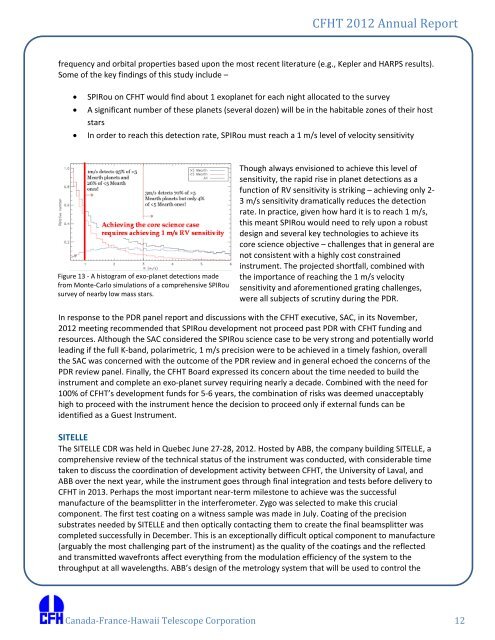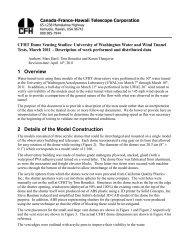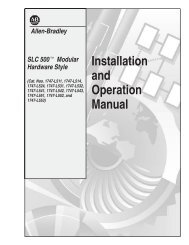2012 CFHT Annual Report - Canada France Hawaii Telescope ...
2012 CFHT Annual Report - Canada France Hawaii Telescope ...
2012 CFHT Annual Report - Canada France Hawaii Telescope ...
Create successful ePaper yourself
Turn your PDF publications into a flip-book with our unique Google optimized e-Paper software.
<strong>CFHT</strong> <strong>2012</strong> <strong>Annual</strong> <strong>Report</strong><br />
frequency and orbital properties based upon the most recent literature (e.g., Kepler and HARPS results).<br />
Some of the key findings of this study include –<br />
<br />
<br />
<br />
SPIRou on <strong>CFHT</strong> would find about 1 exoplanet for each night allocated to the survey<br />
A significant number of these planets (several dozen) will be in the habitable zones of their host<br />
stars<br />
In order to reach this detection rate, SPIRou must reach a 1 m/s level of velocity sensitivity<br />
Figure 13 ‐ A histogram of exo‐planet detections made<br />
from Monte‐Carlo simulations of a comprehensive SPIRou<br />
survey of nearby low mass stars.<br />
Though always envisioned to achieve this level of<br />
sensitivity, the rapid rise in planet detections as a<br />
function of RV sensitivity is striking – achieving only 2‐<br />
3 m/s sensitivity dramatically reduces the detection<br />
rate. In practice, given how hard it is to reach 1 m/s,<br />
this meant SPIRou would need to rely upon a robust<br />
design and several key technologies to achieve its<br />
core science objective – challenges that in general are<br />
not consistent with a highly cost constrained<br />
instrument. The projected shortfall, combined with<br />
the importance of reaching the 1 m/s velocity<br />
sensitivity and aforementioned grating challenges,<br />
were all subjects of scrutiny during the PDR.<br />
In response to the PDR panel report and discussions with the <strong>CFHT</strong> executive, SAC, in its November,<br />
<strong>2012</strong> meeting recommended that SPIRou development not proceed past PDR with <strong>CFHT</strong> funding and<br />
resources. Although the SAC considered the SPIRou science case to be very strong and potentially world<br />
leading if the full K‐band, polarimetric, 1 m/s precision were to be achieved in a timely fashion, overall<br />
the SAC was concerned with the outcome of the PDR review and in general echoed the concerns of the<br />
PDR review panel. Finally, the <strong>CFHT</strong> Board expressed its concern about the time needed to build the<br />
instrument and complete an exo‐planet survey requiring nearly a decade. Combined with the need for<br />
100% of <strong>CFHT</strong>’s development funds for 5‐6 years, the combination of risks was deemed unacceptably<br />
high to proceed with the instrument hence the decision to proceed only if external funds can be<br />
identified as a Guest Instrument.<br />
SITELLE<br />
The SITELLE CDR was held in Quebec June 27‐28, <strong>2012</strong>. Hosted by ABB, the company building SITELLE, a<br />
comprehensive review of the technical status of the instrument was conducted, with considerable time<br />
taken to discuss the coordination of development activity between <strong>CFHT</strong>, the University of Laval, and<br />
ABB over the next year, while the instrument goes through final integration and tests before delivery to<br />
<strong>CFHT</strong> in 2013. Perhaps the most important near‐term milestone to achieve was the successful<br />
manufacture of the beamsplitter in the interferometer. Zygo was selected to make this crucial<br />
component. The first test coating on a witness sample was made in July. Coating of the precision<br />
substrates needed by SITELLE and then optically contacting them to create the final beamsplitter was<br />
completed successfully in December. This is an exceptionally difficult optical component to manufacture<br />
(arguably the most challenging part of the instrument) as the quality of the coatings and the reflected<br />
and transmitted wavefronts affect everything from the modulation efficiency of the system to the<br />
throughput at all wavelengths. ABB’s design of the metrology system that will be used to control the<br />
<strong>Canada</strong>‐<strong>France</strong>‐<strong>Hawaii</strong> <strong>Telescope</strong> Corporation 12




![Documentation [PDF] - Canada France Hawaii Telescope ...](https://img.yumpu.com/26965302/1/190x245/documentation-pdf-canada-france-hawaii-telescope-.jpg?quality=85)







